Your location: Rideau Canal Home Page > Ecology of the Rideau > Fauna of the Rideau

Loons in Hoggs Bay, Big Rideau Lake
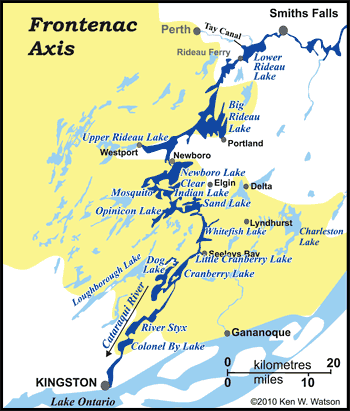 The Rideau spans a wide variety of ecosystems, due in part to the underlying geology and man's activity in the last 200 years. The Frontenac Axis, a section of the Canadian Shield (Precambrian rocks - very old) underlies the Rideau from Kingston Mills to Lower Rideau Lake. These hard rocks form rugged topography (hills, ravines), including the basins for the lakes on the system. Most of the lakes are underlain by crystalline limestone which acts as a buffer against acid rain (hence the lakes are very productive for fish and other aquatic life). Outside of the Frontenac Axis, younger (Palaeozoic) flat lying sedimentary rocks form the underlying bedrock (it is from these rocks that the stones for the dams and locks were quarried). The Rideau spans a wide variety of ecosystems, due in part to the underlying geology and man's activity in the last 200 years. The Frontenac Axis, a section of the Canadian Shield (Precambrian rocks - very old) underlies the Rideau from Kingston Mills to Lower Rideau Lake. These hard rocks form rugged topography (hills, ravines), including the basins for the lakes on the system. Most of the lakes are underlain by crystalline limestone which acts as a buffer against acid rain (hence the lakes are very productive for fish and other aquatic life). Outside of the Frontenac Axis, younger (Palaeozoic) flat lying sedimentary rocks form the underlying bedrock (it is from these rocks that the stones for the dams and locks were quarried).
The area has been actively logged since before the canal was built, the entire area cut over several times. Most of the region (including many of the islands in the lakes) was farmed or used for cattle pasture at one time. By the early 20th century, small farms on poor Frontenac Axis lands were being abandoned in favour of better (more productive) pastures.
So today, along the Rideau you'll find forested areas (some now 100 years mature), active farmland, scrubland and abandoned farmland, low density cottage/summer home developed (rural) land and urban land. The forests are generally mixed, deciduous trees (oak, maple, ash, basswood, birch, elm) and conifer trees (most commonly white pine, white spruce and cedar). On flat lying topography you'll find cedar swamps, hardwood (black ash & silver maple) swamps, and bogs. Along the margins of the Rideau Canal you'll find cattail marshes. All these areas support a varied and healthy wildlife population.
The following is a list of the most common wildlife that you might spot on your Rideau journey. All photos are by Ken W. Watson (see photography note at bottom of page):
Water Birds (on or near the water)
We have lots of water birds on the Rideau. In spring and fall the lakes and marshland areas along the Rideau are host to migratory birds. During the summer we have several types of birds (shown below) that are resident on the Rideau.
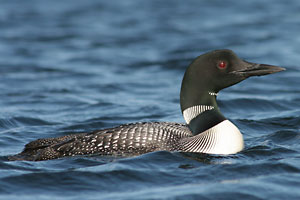 |
|
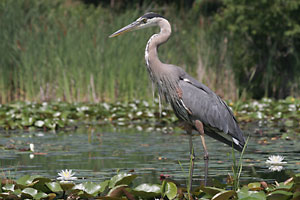 |
Common Loon On all the lakes plus parts of the rivers, this bird is distinctive for its haunting call. It's a diving bird, swimming underwater to catch fish |
|
Great Blue Heron Along the entire Rideau, a large bird usually seen wading near shore. If you see a white one, it's an American Egret. |
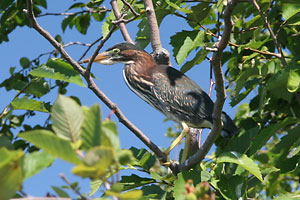 |
|
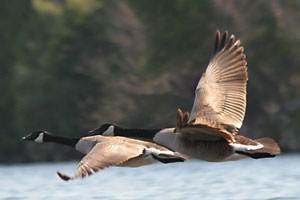 |
Green Heron Most commonly in the shallow water sections (Colonel By Lake, River Styx, Rideau River) this is a small heron. Usually seen perched in a tree. |
|
Canada Goose Yes, we have these on the Rideau (more each year) |
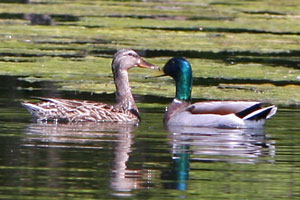 |
|
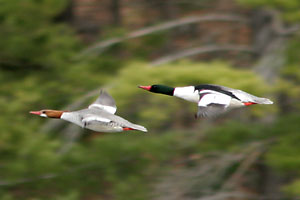 |
|
Mallard duck These ducks quack when flushed. The male has a distinctive green head |
|
Common Merganser duck This duck has a pointed red bill - the male has a dark green head, the female a brown head |
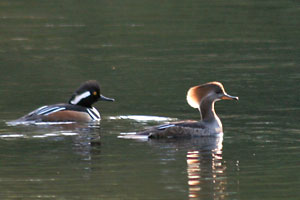 |
|
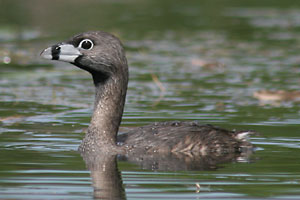 |
Hooded Merganser Most often seen in spring on the Rideau |
|
Pied-billed Grebe A small diving bird |
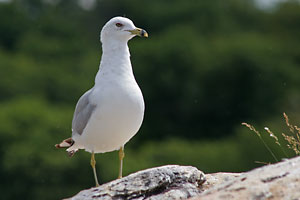 |
|
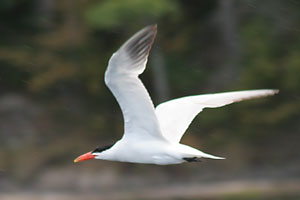 |
Ring-billed Gull A gull with mark on bill |
|
Caspian Tern The Caspian Tern, a large white tern with dark orange bill, the Common Tern, a somewhat smaller tern and the Black Tern, small tern with black body (adult) |
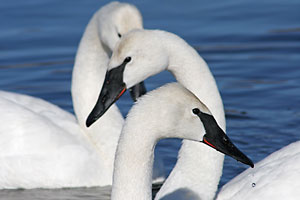 |
|
Trumpeter Swans An extirpated native species in this region, they were re-introduced in the 1990s. They can now be commonly seen throughout the southern part of the Rideau Canal. |
Other Birds (can be found in the near-water environment)
There are many other types of birds that you might spot in the near-water environment; red-tailed hawks, red-winged blackbirds, turkey vultures, turkeys, ruffed grouse and many more (bring along your bird book). A few are shown below.
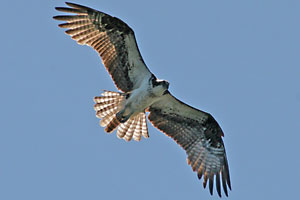 |
|
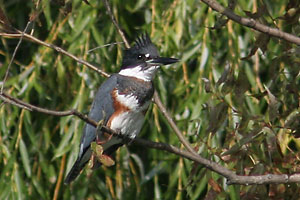 |
Ospreys Now common along the Rideau - often spotted in their large nest made of sticks perched high in a pine tree or a power line stanchion. It dives to catch fish (quite spectacular to see) |
|
Belted Kingfisher A very skittish bird - you'll most likely see it flying away from you. |
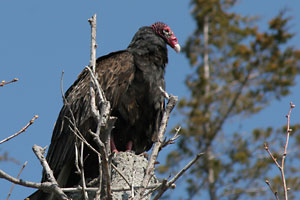 |
|
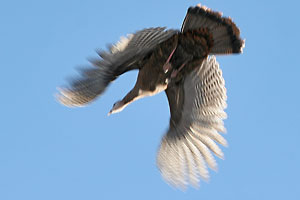 |
Turkey Vulture Can often be seen sitting in the top of a dead tree |
|
Wild Turkeys Yes, wild turkeys can indeed fly. |
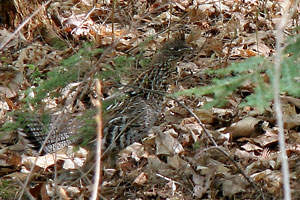 |
|
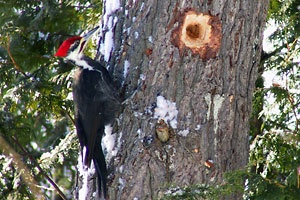 |
Ruffed Grouse This well camouflaged bird, usually found foraging on the ground, takes off with rapid wing motion when flushed. |
|
Pileated Woodpecker A large woodpecker - you'll hear it pounding away at a tree. |
Reptiles and Amphibians
We've got a healthy population of reptiles and amphibians including turtles, the most likely to be seen are the Common Map Turtle, Common Snapping Turtle, and Midland Painted Turtle. There also three other less commonly seen turtles, the Stinkpot Turtle (aka Musk Turtle) a small turtle found in areas with aquatic plant growth; Blanding's Turtle with a "war helmet" type shell and bright yellow chin and throat, usually found in wetlands and the Spotted Turtle, a small turtle with bright yellow spots on its shell, usually found in areas with aquatic plants and a silt bottom.
We've got lots of frogs that will provide you with a nightly serenade. The two biggest are the bullfrog and the green frog. Also the leopard frog, spring peeper and many others.
We've also got snakes, but not any poisonous ones. The two largest snakes are the Northern Water Snake and the Black Rat Snake - both generally found near water. The common garter snake can also be found throughout the region.
We've also got salamanders, mudpuppies and skinks.
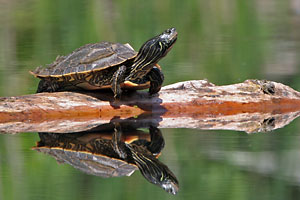 |
|
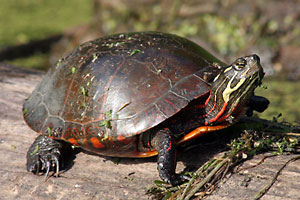 |
Common Map Turtle These turtles have a peaked shell and yellow-orange lines on the skin and shell |
|
Midland Painted Turtle These turtles have a rounded smooth shell with bright red splotches along the edge |
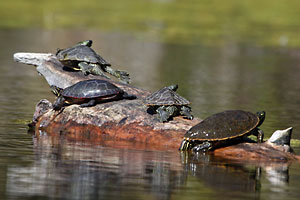 |
|
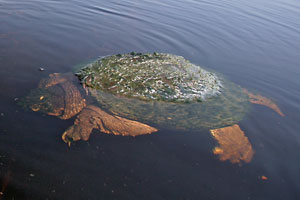 |
Sunning Turtles You'll most commonly see turtles sunning themselves on rocks or logs. Here we see one painted turtle (middle left) and three map turtles (peaked shell and not as colourful as the painted turtle) |
|
Eastern Snapping Turtle The Snapping turtle almost always stays in the water, you'll find it floating or slowly swimming near marshy areas. |
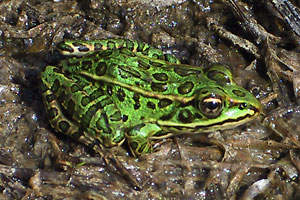 |
|
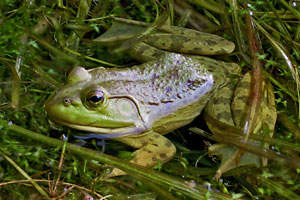 |
Northern Leopard Frog A common frog found in the near water and meadow/pond environment |
|
American Bullfrog One of the most common frogs on the Rideau. We also have the Green Frog which is similar, but slightly smaller with a dorsal fold down the back. The bullfrog has a dorsal fold that only wraps around the ear. |
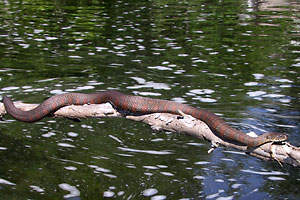 |
|
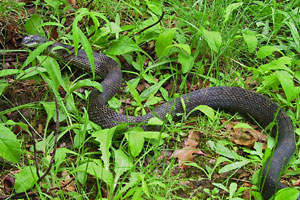 |
Northern Water Snake A fairly large (up to 4 feet) non-venomous snake found in the near-water environment. |
|
Black Rat Snake The largest snake on the Rideau (in fact, the largest snake in Canada - up to 8 feet), this non-venomous snake prefers near-water wooded areas. It has the ability to climb trees. |
Mammals
In the near shore environment you'll likely spot muskrats and beavers. You may even spot the somewhat reclusive river otter (found in the lakes here as well as rivers). And there are the usual Eastern Ontario mammals to be sometimes found near the water: raccoons, black, grey and red squirrels, chipmunks, foxes, coyotes, white-tailed deer, porcupines and skunks. Black bears, although quite rare in the region, are present.
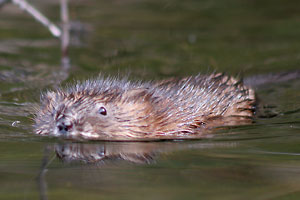 |
|
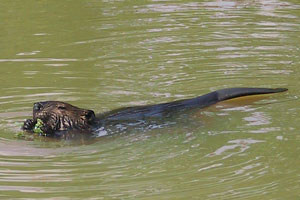 |
Muskrat Most often seen swimming near shore. It has a thin bare tail. |
|
Beaver You'll usually spot a dam or lodge made of sticks before you see the beaver. Has a broad flat tail that it slaps the water with when disturbed. |
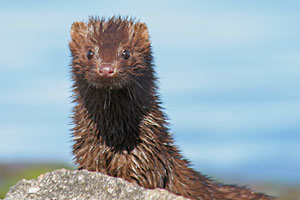 |
|
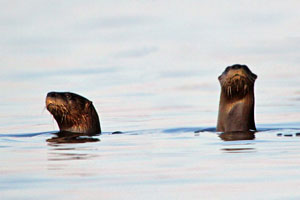 |
American Mink Often seen foraging near shore. |
|
River Otter These tend to be somewhat reclusive and are usually found as a family grouping. They present a characteristic inquisitive "heads-up" in the water. |
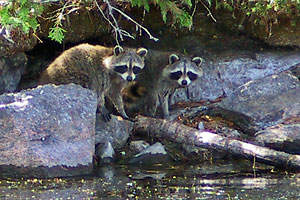 |
|
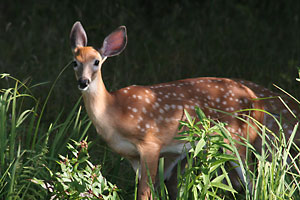 |
Raccoons These usually forage at night, but can sometimes be spotted during the day. |
|
White Tailed Deer (fawn) There are large populations on these along the Rideau. The young fawns have a spotted coat. |
Fish
The Rideau is home to healthy populations of many fish species. The lakes and most of the rivers are home to species such as Large Mouth Bass, Small Mouth Bass, Northern Pike and Crappie. Lake Trout are present in some lakes that have depths in excess of 80 ft / 24 m (i.e. Big Rideau Lake). There are Walleye in some areas (i.e. Upper Rideau Lake and the Rideau River) and Muskellunge (Musky/Maskinonge) in some sections of the Rideau River.
Photography
The pictures on this page are all "by chance" wildlife photos - wildlife that I've come across as I paddle portions of the Rideau. Those interested in some tips for taking good photos of wildlife should view "The Nature of Wildlife Photography" on my website at: www.rideau-info.com/canal/ecology/nature-photography.html
One photography hint, a very simple one, is to choose a paddling route that puts the sun to your back for most of the day. Try to choose a route that has you on a west shore in the morning, a north shore at mid-day and an east shore in the afternoon. For those doing the entire Rideau, this means going from Kingston to Ottawa rather than the other way around. This will put the wildlife that you see on your paddle in the best light.
 | |  |
Comments: send me email: Ken Watson
©1996- Ken W. Watson
|